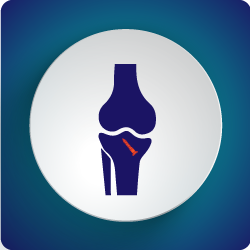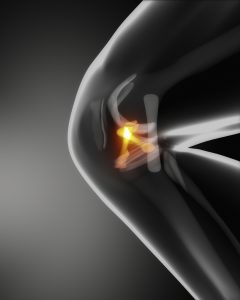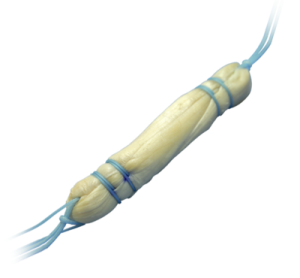
Whats new in Anterior Cruciate Ligament reconstruction techniques
For sporting players who injure their knee, an Anterior Cruciate Ligament (ACL) injury can be the end of their career. The ACL is a structure within the knee that provides stability to the knee, especially when twisting and turning. It is called an “Anterior Cruciate Ligament” because Anterior means “Front” and is where the ligament attaches to the leg bone (Tibia), and Cruciate means “Crossed” as it crosses with another ligament, the Posterior Cruciate Ligament.

Anterior & posterior cruciate ligaments
The most common way to injury an Anterior Cruciate Ligament is when a side force is applied to the knee, or the knee is hyperextended (Straightened past the natural end of knee straightening). This results in a rupture, and an athlete may feel a snap or pop in the knee, along with immediate swelling in the knee joint itself. This is due to a small blood vessel that runs within the ACL, that bursts when the ACL ruptures. It is most common in Footballers, Soccer Players, Netballers, Basketballers, Martial artists, Squash players and anyone else who participates in pivoting activities.
When the Anterior Cruciate Ligament is ruptured, it cannot heal back at the correct length. The torn ends flop back onto the posterior cruciate ligament and heal in a relaxed position, rather than the normal, tight position. It is ineffective in that position. You do not need a cruciate ligament to walk. It is only necessary when you are pivoting on the knee such as in sports.
After a rupture, a period of rehabilitation can start, to see if the knee can be strengthened to a point that an ACL is not required. For people are do not play high level sports, or do not wish to return to pivoting sports, this may be the best option. For people who want to play sports, especially high performance athletes, an ACL reconstruction is usually necessary. Traditionally there have been 2 graft options, and several ways to insert the graft.
Hamstring Graft
The hamstrings are taken from the front of the leg, and 2 tendons are used to create a graft big enough for reconstructing the ligament. The Gracilis and Semitendinosis are the ones most commonly harvested. These create a graft that is long enough to be secured within tunnels in the bone of the knee (Femur and Tibia). The width of this graft is dependent on the width of the patients tendon, and is usually 5-10mm wide. The thicker the graft, the stronger it is, but is usually proportional to the size of the patient. Over time, the hamstring tendon undergoes what’s called Ligamentisation (Turning into a ligament). Hamstring grafts are reliable and are the most common way that Anterior Cruciate Ligament reconstructions are being performed in Adelaide.
Newer techniques use only 1 hamstring, and obtain thicker grafts by securing them in a technique where the graft is quadrupled on itself. This has been shown to be superior in strength to other grafts in recent studies.
Bone Patella Bone Graft
The next most popular option is using the Patella tendon, along with bone from both sides of the tendon (Patella and Tibia). A bony wedge is taken along with the tendon, and is used to secure the graft in the same bony tunnels that are created when performing any Anterior Cruciate Ligament reconstruction. This is usually secured with screws that sit alongside the bone and squash it into the walls.
Artificial Graft
10 years ago, an artificial graft substance called LARS ligament was being used to avoid the need to harvest graft from the person having surgery. This had the advantage of allowing a player to return back to sport quickly. The longer term results however, revealed that these grafts were not as long lasting as your own tendons. Lars Ligaments are still used, but only when there is a lack of other graft substances in the knee, or if a posterior cruciate ligament is being reconstructed, where it has shown success. It is rarely used in primary ACL reconstructions today.
1 or 2 Hamstrings
With the Graftlink technique, only 1 hamstring is required. This allows the other hamstring to remain in place, with the hope that this decreases the morbidity associated with harvesting the graft. This does not change the recovery rate of the surgery, but potentially helps with the strength of the leg in rehabilitation. Current studies show that a 1 hamstring technique can be even stronger than the 2 hamstring techniques, as it is created in a way that is generally wider than the 2 hamstring technique.
Method of tunnel drilling
Over the last 5 years, there has been a general movement towards drilling one of the tunnels through a small cut on the side of the knee, like a normal arthroscopy incision, rather than the traditional way of drilling through a hole in the tibial bone. The reason for this is that you can place the tunnel exactly where you need to, as it is not affected by where the hole in the tibia is placed. If you drill through the hole in the tibia, the hole in the femur is relatively set and the correct position may not be achieved.

Graftlink Cruciate Reconstruction
How does Dr Liew perform ACL reconstructions?
- Single Hamstring using Graftlink technology
- Drilling through the arthroscopy portal rather than through bone.
- Specialised buttons at the end of the graft, avoiding screws in the bone.
- Overnight stay in hospital
- Crutches for 1 week
- Weight bearing immediately after surgery
- Dedicated physiotherapy program.
- Return to high level, elite sport at 9 months to 1 year post op.
Thankyou for visiting this website. Please note that the information held within this site and on this page are for educational purposes only. Please consult your doctor or health professional always prior to considering any medical therapy or intervention. If you notice an error on this site, please use our contact form to let us know so we can rectify any issues. All information and graphics on this site are the property of Sempire Designs.
